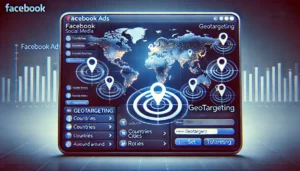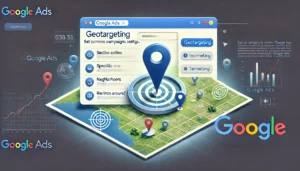Geotargeting: The Secret Weapon for Local Businesses

In today’s digital world, local businesses need to stand out to attract nearby customers. One powerful way to do this is through geotargeting. This technique uses location data to deliver ads and content to people in specific areas. By using geotargeting, local businesses can reach their ideal customers more effectively.
Key Takeaways
- Geotargeting allows businesses to deliver ads based on a user’s location.
- It helps local businesses attract nearby customers with relevant offers.
- Using geotargeting can improve customer engagement and loyalty.
- Businesses can use various platforms like Google Ads and Facebook Ads for geotargeting.
- It’s important to respect user privacy and follow local laws when using geotargeting.
Understanding Geotargeting and Its Importance
What is Geotargeting?
Geotargeting is a marketing strategy that uses a person’s location to deliver relevant ads or content. When someone goes online, their device sends out a signal with their location. Ad platforms use this data to show them ads that are relevant to where they are. It’s like having a billboard that only appears to people in your neighbourhood!
How Geotargeting Works
Geotargeting works by using data from a user’s device, such as their IP address, GPS, or Wi-Fi signals, to determine their location. This information helps decide what content or ads the user sees. For example, if you’re looking for a coffee shop, your phone will show ads for nearby coffee shops using geotargeting.
Benefits of Geotargeting for Local Businesses
Geotargeting offers several benefits for local businesses:
- Enhanced Relevance: Ads are more relevant to the audience, increasing the chances they’ll pay attention.
- Improved Ad Performance: Location-based targeting often results in better ad performance.
- Targeted Local Promotions: Helps drive in-store traffic by targeting customers within a specific radius.
- Increased Engagement: Personalised and location-relevant ads are more likely to capture attention.
- Better Understanding of Customer Behaviour: Helps businesses understand customer preferences in different regions.
Geotargeting is like a GPS for your ads, ensuring they reach the right people in the right places.
By focusing on your target area, you’re not wasting money on clicks from people who can’t visit your store. This makes your advertising budget more effective and improves your return on investment.
Implementing Geotargeting in Your Marketing Strategy
Setting Up Geotargeting Campaigns
To start with geotargeting, we need to define our objectives. Are we aiming to increase foot traffic, boost online sales, or enhance brand awareness? Once we have clear goals, we can move on to understanding our target audience. This involves analysing customer data to identify key demographics and preferences. Knowing our audience helps us create more effective ads.
Choosing the Right Platforms
Selecting the right platforms is crucial for the success of our geotargeting campaigns. Different platforms offer unique advantages. For instance, Google Ads allows us to target users based on search queries, while Facebook Ads can target users based on their interests and behaviours. We should choose platforms that align with our business goals and audience.
Measuring Success
Measuring the success of our geotargeting campaigns is essential to understand their impact. We can use metrics like click-through rates, conversion rates, and return on ad spend (ROAS) to evaluate performance. It’s important to regularly review these metrics and adjust our strategies accordingly to ensure we are meeting our objectives.
By focusing on our target area, we’re not wasting money on clicks from people who can’t visit our showroom or restaurant.
Geotargeting for Social Media Advertising
Facebook Ads
When it comes to Facebook Ads, geotargeting allows us to reach users based on their specific locations. We can target users by country, city, or even a specific radius around a location. This ensures our ads are seen by the right people at the right time. By focusing on local audiences, we can create more relevant and engaging ads that resonate with users’ immediate surroundings.
Instagram Ads
Instagram, being a visual platform, benefits greatly from geotargeting. We can tailor our ads to appear in the feeds of users in specific locations, making our content more relevant. For instance, a local restaurant can showcase its dishes to users nearby, enticing them to visit. This personalised approach can significantly boost engagement and drive foot traffic to local businesses.
Twitter Ads
Twitter Ads also offer robust geotargeting options. We can target users based on their location, ensuring our tweets reach the right audience. This is particularly useful for promoting local events or time-sensitive offers. By leveraging geotargeting, we can make our Twitter campaigns more effective and relevant to users’ current locations.
Geotargeting on social media platforms like Facebook, Instagram, and Twitter allows us to create highly targeted and relevant ad campaigns. This not only improves ad performance but also enhances user engagement by delivering content that resonates with their immediate environment.
Leveraging Geotargeting for Search Engine Marketing
Google Ads
When it comes to geotargeting, Google Ads is a powerful tool. We can set up campaigns to target specific locations, whether it’s a city, a neighbourhood, or even a radius around a point. This ensures our ads reach the right audience. A well-executed Google ads audit can reveal opportunities to refine our targeting and improve performance.
Bing Ads
Bing Ads also offers robust geotargeting features. We can target users based on their location, which helps in reaching a more relevant audience. This is particularly useful for businesses looking to expand their reach beyond Google. Regular PPC audits can help us optimise our Bing Ads campaigns for better results.
Best Practises for SEM Geotargeting
- Define Your Target Area: Start by identifying the geographic areas that are most relevant to your business.
- Use Local Keywords: Incorporate local terms into your ad copy to make it more relevant to the target audience.
- Monitor and Adjust: Keep an eye on the performance of your geotargeted campaigns and make adjustments as needed.
- Leverage Local Events: Tailor your ads to local events or holidays to increase engagement.
Geotargeting in search engine marketing allows us to connect with potential customers in a more meaningful way. By focusing on specific locations, we can make our ads more relevant and effective.
Incorporating geotargeting into our PPC management strategy can significantly boost our return on ad spend (ROAS). This approach not only improves ad relevance but also enhances our understanding of customer behaviour in different regions.
Geotargeting in E-commerce
Amazon Ads
Amazon Ads are a powerful tool for e-commerce businesses. By using geotargeting, we can show ads to customers based on their location. This means we can tailor our ads to meet the needs of different regions. For example, we might promote winter clothing in colder areas and summer gear in warmer regions. This approach ensures our ads are relevant and timely.
Personalised Shopping Experiences
Geotargeting allows us to create personalised shopping experiences for our customers. By understanding where our customers are located, we can offer products and promotions that are more likely to appeal to them. This not only improves customer satisfaction but also boosts sales. Imagine a customer in a coastal town receiving ads for beachwear and accessories. They are more likely to make a purchase because the ads are relevant to their lifestyle.
Boosting Local Sales
One of the biggest benefits of geotargeting is the ability to boost local sales. By targeting customers in specific areas, we can drive more traffic to our online store and increase sales. For instance, if we notice that sales are low in a particular region, we can increase our ad spend in that area to attract more customers. This strategy is especially useful for small businesses looking to expand their reach.
Geotargeting is a game-changer for e-commerce businesses. It allows us to connect with customers on a more personal level and drive sales in specific regions. By leveraging this technology, we can create more effective marketing campaigns and improve our overall business performance.
Advanced Geotargeting Techniques
Geofencing
Geofencing is a powerful tool that lets us create a virtual boundary around a specific location. When someone enters this area, it triggers an action, like sending a push notification. This technique is great for engaging customers who are nearby and encouraging them to visit our store. Imagine walking past a coffee shop and getting a notification about a special discount—it’s that immediate and relevant.
Beacon Technology
Beacon technology takes geofencing a step further. Beacons are small devices that use Bluetooth to send signals to nearby smartphones. They can provide highly accurate location data, making it possible to deliver personalised messages to customers right when they are in our store. For example, a customer in the shoe section could receive a notification about a sale on trainers.
Location-Based Push Notifications
Location-based push notifications are another effective way to use geotargeting. These notifications are sent to users based on their current location, offering timely and relevant information. Whether it’s a flash sale or an event, these notifications can drive immediate action. This method ensures that our messages are always relevant and timely.
By leveraging these advanced geotargeting techniques, we can create more personalised and effective marketing campaigns. This not only improves customer engagement but also boosts our sales and brand loyalty.
Creating Effective Geotargeted Content
Localised Ad Copy
When crafting ad copy for geotargeting, we need to make sure it resonates with the local audience. This means using local slang, mentioning nearby landmarks, or even referencing local events. Personalisation is key to making the ad feel relevant and engaging.
Using Local Keywords
Incorporating local keywords into our content can significantly boost our visibility in local searches. For instance, instead of just using “coffee shop,” we might use “coffee shop in Manchester.” This helps us appear in searches from people nearby, making our ads more effective.
Tailoring Content to Local Events
Aligning our content with local events can create a stronger connection with our audience. Whether it’s a local festival, sports event, or community gathering, referencing these events in our ads can make them more relatable and timely.
By focusing on localised content, we can ensure our ads are not just seen but also remembered and acted upon.
Geotargeting for Video Advertising
YouTube Ads
YouTube is a powerful platform for video advertising. By using geotargeting, we can ensure our ads reach the right audience in specific locations. This means our ads are more relevant and engaging. Geotargeting on YouTube allows us to focus on users in particular cities or even neighbourhoods. This precision helps in reducing wasted ad spend and increasing our return on investment.
TikTok Ads
TikTok has become a popular platform for short, engaging videos. With geotargeting, we can tailor our ads to specific regions, making them more relevant to local users. This approach not only boosts engagement but also helps in building a local community around our brand. We can use local trends and events to make our ads more appealing.
Maximising Engagement with Video
To get the most out of our video ads, we need to consider the timing and frequency of our ads. It’s important to find a balance; we don’t want to overwhelm users with too many ads, but we also need to ensure our brand stays top of mind. By analysing user behaviour and preferences, we can optimise our ad schedules for better engagement. Additionally, using localised content and keywords can make our ads more relatable and effective.
Optimising Landing Pages for Geotargeted Traffic
Designing Localised Landing Pages
Creating landing pages that speak directly to local audiences is crucial. We need to include local landmarks, events, and even local slang to make the content relatable. This approach helps in building trust and making the audience feel at home. Localised content can significantly improve engagement and conversion rates.
A/B Testing for Better Results
A/B testing is essential for understanding what works best for different regions. By testing various elements like headlines, images, and calls to action, we can determine what resonates most with our audience. This method allows us to refine our strategies and maximise our ROI.
Integrating with Geotargeted Ads
Integrating landing pages with geotargeted ads ensures a seamless user experience. When users click on an ad, they should be directed to a page that matches the ad’s message and location. This consistency is key to maintaining user interest and driving conversions.
By focusing on localised content and continuous testing, we can create landing pages that not only attract but also convert local traffic effectively.
Incorporating these strategies will help us make the most of our geotargeting efforts, ensuring that our landing pages are as effective as possible.
Legal and Ethical Considerations in Geotargeting
Respecting User Privacy
User privacy is a top priority in today’s digital world. We must ensure our practises comply with federal, state, and local regulations. This means being honest about our data collection, retention, and sharing practises. Transparency builds trust with our audience. We should also provide users with the option to opt out of data collection.
Compliance with Local Laws
Different regions have different laws regarding data privacy and advertising. It’s crucial to stay updated on these laws to avoid legal issues. We need to ensure our geotargeting campaigns are compliant with all relevant regulations. This includes understanding the nuances of laws in various locations.
Transparent Data Practises
Being transparent about how we use data is essential. Users should know what data we collect, how we use it, and who we share it with. This transparency not only builds trust but also helps us stay compliant with legal requirements. We should always aim to use data ethically and responsibly.
Ensuring ethical and legal compliance in geotargeting is not just about following the law; it’s about building a trustworthy relationship with our audience.
Future Trends in Geotargeting
AI and Machine Learning
Artificial Intelligence (AI) and Machine Learning (ML) are set to revolutionise geotargeting. These technologies can analyse vast amounts of data to predict customer behaviour and preferences. By leveraging AI, businesses can create highly personalised ads that resonate with local audiences. Imagine a coffee shop offering a discount just as you walk by, based on your past visits.
Integration with Augmented Reality
Augmented Reality (AR) combined with geotargeting is a game-changer. This integration allows for immersive, location-based experiences. For example, a fashion brand could create an AR scavenger hunt that guides users to different stores to collect virtual items, culminating in a real-world discount. This not only engages customers but also drives foot traffic.
The Evolution of Mobile Geotargeting
Mobile geotargeting is evolving rapidly. With the increasing use of smartphones, businesses can now reach customers wherever they are. Location-based push notifications, for instance, can alert users to nearby deals or events. This real-time engagement can significantly boost customer interaction and sales.
As we look ahead, the convergence of AR technology and geo-targeting is expected to yield a new breed of personalised advertisements that can transform mundane environments into interactive marketing playgrounds.
In summary, the future of geotargeting is bright, with AI, AR, and mobile technologies leading the way. These advancements will enable businesses to connect with customers in more meaningful and engaging ways.
The future of geotargeting is bright and full of potential. As technology advances, businesses can reach their audience more precisely than ever before. Imagine being able to target customers based on their exact location and preferences. This is not just a dream; it’s happening now. Stay ahead of the curve and learn more about how geotargeting can benefit your business. Visit our website for a free consultation and see how we can help you achieve your marketing goals.
Conclusion
In today’s digital age, geotargeting stands out as a powerful tool for local businesses. By focusing on specific areas, businesses can connect more effectively with their community, driving foot traffic and boosting sales. This strategy not only helps in reaching the right audience but also ensures that marketing efforts are both efficient and impactful. As technology continues to evolve, the potential for geotargeting will only grow, making it an essential component for any local business looking to thrive in a competitive market. Embrace geotargeting and watch your business flourish.
Frequently Asked Questions
What is geotargeting?
Geotargeting is a way to deliver content to users based on their geographic location. It helps businesses reach customers in specific areas.
How does geotargeting work?
Geotargeting uses data from a user’s device, like GPS or IP address, to determine their location and show them relevant ads or content.
What are the benefits of geotargeting for local businesses?
Geotargeting helps local businesses by making ads more relevant, improving customer engagement, and reducing wasted ad spend.
How can I set up a geotargeting campaign?
To set up a geotargeting campaign, choose your target area, select the right platforms, create localised content, and monitor the results.
Which platforms support geotargeting?
Many platforms support geotargeting, including Google Ads, Facebook Ads, Instagram Ads, and Twitter Ads.
What is geofencing?
Geofencing is a technique that creates a virtual boundary around a location. When users enter this area, they receive targeted messages or ads.
How can geotargeting improve my social media ads?
Geotargeting can make social media ads more relevant by showing them to users in specific locations, increasing the chances of engagement.
Are there any legal considerations with geotargeting?
Yes, it’s important to respect user privacy and comply with local laws when using geotargeting. Always be transparent about data practises.
Author
Search Blog
Free PPC Audit
Subscribe to our Newsletter
The Voices of Our Success: Your Words, Our Pride
Don't just take our word for it. With over 100+ five-star reviews, we let our work-and our satisfied clients-speak for us.
"We have been working with PPC Geeks for around 6 months and have found Mark and the team to be very impressive. Having worked with a few companies in this and similar sectors, I rate PPC Geeks as the strongest I have come across. They have taken time to understand our business, our market and competitors and supported us to devise a strategy to generate business. I value the expertise Mark and his team provide and trust them to make the best recommendations for the long-term."
~ Just Go, Alasdair Anderson




